 A California stream orchid growing beneath a large boulder beside a seep in an otherwise dry creek feeding into a seasonal tributary of the Santa Ynez River.
A California stream orchid growing beneath a large boulder beside a seep in an otherwise dry creek feeding into a seasonal tributary of the Santa Ynez River.
I think that all but the keenest, most experienced observers would never suspect there is flowing water up this dry wash when looking at it from the flats below. The arroyo, however, turns into a small, bouldery creek bed that cuts a deep gash into the mountainside, but it’s hidden from plain sight until one gets right up to it. And through a short section of the miniature canyon, even in this year of record drought, water flows.
The creek bed is shaded through midday in the dappled light of a sparse cover of oak and sycamore trees, a mountainside casting a shadow over it through early morning and a massive outcrop shading the area by late afternoon.
Here in this unlikely moist nook, filled with a melange of scents comprised of the sweetness of trickling clear water, the earthy fragrance of wet sediment, and spiked with effluvial hints of decomposing organic matter, a place surrounded by parched south and west facing chaparral-covered hills that are blistering hot in summer months, California stream orchids thrive in abundance.
 A rather large orchid yet to bloom.
A rather large orchid yet to bloom.
I recall the first time I saw this type of orchid in the wild, which is notable, for no other first experience with a native wildflower sticks out so prominently in my mind. I was about 10 or 11 years old exploring the forest with a friend and we found a small clump growing along Mono Creek, just below the campground and debris dam.
I was surprised to find orchids growing in this semi-arid region of south-central California, though this portion of Mono Creek tends to be exceptionally lush relative its upper reaches and other creeks in general. Nonetheless, the orchids seemed out of place even in the “Mono Jungle.”
I didn’t actually know for sure that they were orchids, but I knew enough to recognize that they certainly resembled orchids, and so that’s what we called them. Always curious, I touched one of the blooms and it moved, under its own power, which made the plant all the more fascinating.
California stream orchids are thigmonastic, meaning that they respond when touched. They move the lower portion of their blooms, presumably as a means to better spread pollen to pollinators that come in contact with their flowers. For this reason they are sometimes referred to as “chatterbox orchids,” for their nastic motions call to mind the jaw movement of a talking person.
 Looking down the dry creek below the seep where the orchids grow.
Looking down the dry creek below the seep where the orchids grow.










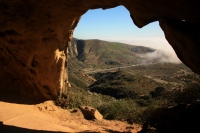

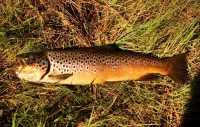
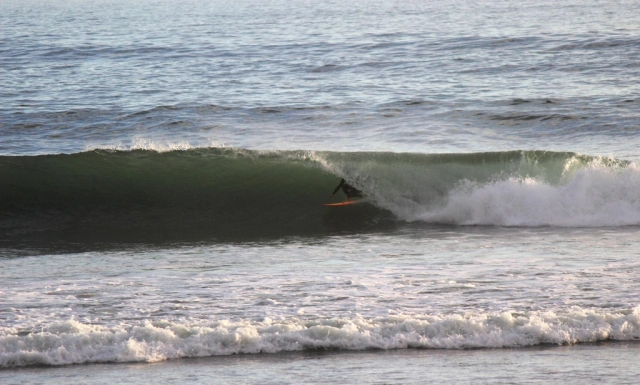

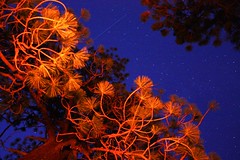








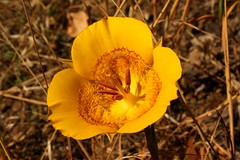









Jack, is this the appropriate forum to ask questions/ recommendations about camping, hikes and backpacking along the Eastern Sierra? Thanks, Richard, Thousand Oaks.
Hey Richard. You’re free to ask whatever I wish, I don’t mind, but I really wouldn’t know much about the Sierra, eastern or otherwise.
Haven’t heard of thigmonastic before – fascinating – never knew plants could do that! It always amazes me how opportunistic plants are and how they can grow in even the smallest amount of water/light or whatever else they need. I love to see trees growing out of rocks – just makes you wonder how on earth they can get nutrients in sufficient quantities and catch enough passing water – but they do. Nature sure is amazing 🙂
Carol.
Hey Carol. I’m always fascinated by trees growing out of rocks. I’m in the habit of taking photos of them, but I’ve never been able to capture them well enough an image in a way that is worth posting.
You could just put them out for interest whether the quality’s good or not?
Nice find, Jack. They are not all that common around here.
Thanks Jack, I was under the impression you were familiar with the Sierra from earlier posts, my mistake. I will focus my questions around the greater SB County region from which you post most of your adventures. Thanks again. Richard
Very interesting Jack! That portion of Mono creek REALLY does look like a jungle. I know what you mean about finding orchids in a semi-arid area. In fact, if you have the time, here is a link to a blog post I did that includes orchids in a totally arid area. I didn’t know they were orchids at first, but they might be the same type as these (or close to it). These aren’t in as good of shape of yours, but the location is pretty cool.
http://patricktillett.blogspot.com/2013/06/desert-oddity-shaffer-fish-bowl-route-66.html
Hey Pat. I checked your post, but didn’t see any mention of the orchids. Neat tank, though.
Hi Jack, that ragged looking plant at the rear of tank is an orchid. I didn’t find that out until afterwards though. It was winter and the orchid looked pretty sad. The fish seemed to be doing just fine.
I see. When I looked earlier it was on my cell phone so the photo was tiny. Not that I would’ve recognized it as an orchid.That’s pretty cool. . .way out in that scorching desert. Must look pretty neat in spring when in bloom over the pool.